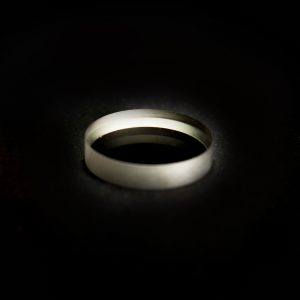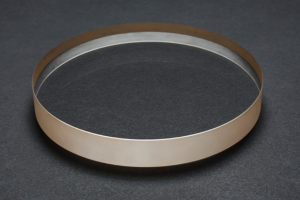Large, highly uniform collection optics
If the spectral band of the target component is extremely narrow or the spectrum is close to the “background” band, or the signal’s contribution to the background is very small, it may be necessary to provide a large narrowband pass filter (NBPF) to enhance wavelength selectivity.
One application is to measure or map lightning from orbit, which requires high wavelength selectivity in a large field of view. Lightning can be studied by observing the triple state line of narrow atomic oxygen at 777.4nm (refer to MeteoSAT LI).
However, it is challenging to know exactly when and where lightning will occur, so a very large detector area is required to maintain this very narrow wavelength selectivity. This requires an extremely uniform, narrow filter. Yirui Electric has demonstrated its ability to produce this NBPF centered on a target wavelength of 20 pm on a working aperture with a diameter of>125 mm.
Figure 1. The spatial variation of CWL over 125 mm diameter shows a highly uniform large NBPF.
The advantages of instruments with such high accuracy and “field of view” must be offset by the increased weight and cost of manufacturing such large and complex filters and related optical elements.
Compact/multispectral imaging
In order to minimize the weight and cost of each “scientific line”, some EO imaging systems try to incorporate as much science as possible into one instrument by using a single detector to cover multiple spectral bands of interest. This multispectral imaging (MSI) leads to the need for filter arrays, where spectral performance can vary spatially across the entire component.
Figure 2.10 Multi spectral array of BPFs (developed under a subcontract from ABB Canada for the Space Technology Development Program of the Canadian Space Agency). Source: Yirui Electric Spectroscopy Technology
By using filters with this multi region structure, various pixel bands on the detector will be sensitive to various spectral bands, so various components or phenomena of interest can be evaluated.
The manufacturing of multi area/multi spectral filter (MZF or MSF) arrays can be accomplished by using a butcher block structure, in which various filters are manufactured, separated and fixed into an array; Or by patterning (by masking) various spectral bands on a single substrate. By combining the assembly and pattern on a single filter array, the hybrid method is also feasible.
The slaughter block MZF array provides the advantage of simplifying the coating process by avoiding the running output of composite coating; Filter manufacturers only need to coat a single strip on any given substrate, which is the method used in most “traditional” optical filter manufacturing.
When evaluating the increasing complexity of multiple (>4 or 5) target stripes or a single filter band, Butcher block array may be a good choice, which will increase the filter coating thickness and reduce the operation success rate.
The patterned MZF array has the potential to produce spectral bands of almost any shape or size (not only stripes or rectangles in meat), and has made considerable improvements in the size of the transition zone (2 times or more).
It may be advantageous to limit the loss of good pixels using a patterned array, since pixels under the transition region are generally not available for analysis. In addition, coating on a monolithic substrate can circumvent challenges related to alignment tolerances between different spectral bands.
High spatial and spectral resolution
By limiting the filter bandwidth related to the target frequency band, you can strengthen the greater distinction between “scientific lines”. In MSI applications, this enhancement of spectral resolution means a loss of spatial resolution because it reduces the signal-to-noise ratio (reducing total light) and aperture size (available pixels) of any single band.
In contrast, if broadband panchromatic (PAN) filters covering the entire visible spectrum are used, the increase in total light at these pixels can provide enhanced spatial resolution. For Landsat 8, PAN band has a higher spatial resolution (15m vs. 30m), which is twice as high as other optical bands (see Table 2).
The combination of PAN and wavelength selective band through “PAN sharpening” can be used to accurately map the source of specific signal and the content represented by the signal.
Robust and reliable optics
If the system can not withstand the conditions of use on the orbit, it is of no value to run a system with a high-resolution optical filter.
By strictly controlling the deposition process (sputtering or enhanced evaporation) and materials, experienced manufacturers can create optical filters with excellent density and adhesion to withstand typical ground requirements of humidity and temperature fluctuations without changing or degrading with use or time.
Typical reliability specifications include:
.Under the following conditions, the spectral performance does not change or the surface quality does not decline:
.24h wet heat exposure (95% relative humidity; 49 ° C)
.Thermal cycle/impact test from – 60 to 70 ° C
.Tape and Friction Adhesion Test
Once these filters and filter arrays are in orbit, they may also have to withstand extreme temperature ranges (as low as 70 K) and solar and electronic radiation normally filtered out by the Earth’s atmosphere. Filters and filter arrays deployed in these environments may require further specialized testing to confirm that they can survive in demanding operating environments.



